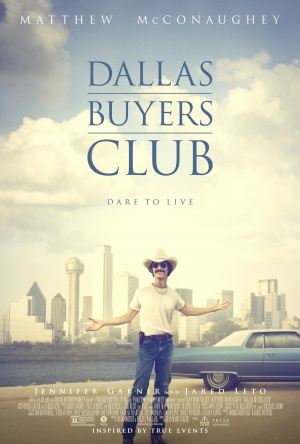“Dallas Buyers’Club,” the brilliant new film from director Jean-Marc Vallee, is the story of Ron Woodruff, a rodeo cowboy living with AIDS in Dallas in the 1980s. The movie follows Woodruff (Matthew McConaughey) from the point of his diagnosis as he becomes accustomed to living with AIDS and attempts to find a source of medication to treat his disease.
Making a quality movie about the AIDS epidemic is a difficult thing to do. Movies that focus on AIDS run the risk of becoming direct examinations of the disease itself or turn into sympathy pieces. As a film crew works toward creating a movie, it is essential that the characters’ stories, not the circumstances that surround their stories, be the main focus of the film. With a condition as important as the AIDS epidemic this is a necessity. In order to do justice to the millions of AIDS patients worldwide it is vital that they be shown as real-life human beings, instead of as characterless victims of a disease.
“Dallas Buyers Club” succeeds fantastically in this regard. At no point does the focus of the film seem to be the disease that Woodruff (Matthew McConaughey, who gives the best performance of his career as the hard-drinking cowboy) is struggling to cope with. Woodruff was a gruff, homophobic, sex-addicted, drug-addled alcoholic at the time of his diagnosis. After collapsing in his trailer-park home, he is taken to a hospital and is informed that he has AIDS and that he has 30 days to live. He lashes out at his doctors, accusing them of labeling him as “gay,” and storms out of the ward, angrily declaring that “nothing can kill f***in’ Ron Woodruff in 30 days.”
The movie’s success lies in the way it portrays Woodruff’s story and the transformation he undergoes. As he become familiar with the community that he has become a part of (namely, that of Dallas AIDS patients in the 1980s), Woodruff begins to see gay men and transgender women, who made up the majority of the community, as his equals; Now, as these individuals have become his fellow patients, Woodruff sees them in a new light.
When AIDS was first becoming a major issue in the 1980s, very few drugs were made readily available to patients. Woodruff sets out to overcome this obstacle, opening a “clinic” that he uses to distribute medicinal drugs that were un-approved by the FDA. Woodruff is forced to change his personal views regarding race and sexuality. He befriends a transgender women named Rayon (the fantastic Jared Leto); the two characters become close friends, and Rayon becomes instrumental in helping him run the Buyers Club.
While watching “Dallas Buyers Club” I was reminded of the 1993 classic “Philadelphia.”
The two films carry many similar themes. In “Philadelphia,” Denzel Washington portrays a black lawyer asked to represent a gay white man (Tom Hanks) who sets out to sue his employers after he is fired due to the fact that he has AIDS. Washington’s character grapples with many of the same obstacles that Woodruff faces in “Dallas Buyers Club” (namely racism and homophobia), and emerges a better person. In “Dallas Buyers Club” the roles are reversed – Woodruff, the patient, is the ignorant one. He is forced to confront his fears head on as he grapples with the disease he is living with.
“Dallas Buyers’Club” is a brilliant piece of art, in that it sheds light on the transformation that a person can undergo through struggle. Matthew McConaughey is phenomenal as Woodruff – he reportedly lost 40 pounds to take on the role. Much of the movie’s success lies in McConaughey’s stellar acting work.
The movie is weak in some areas. Aside from Leto, the film’s supporting cast is weak and does little to help bring the movie’s setting to life. Jennifer Garner is stiff and one-note as the nurse who treats Woodruff during his time in the hospital. Garner’s role did not contain much substance – her poor performance was not entirely her fault. But her character did little to add depth or meaning to the film, and I felt that had she invested more into her role, her character could have taken on a much greater significance within the context of the film. McConaughey’s performance is so strong, though, that the weaknesses of the supporting cast are easily overlooked.
“Dallas Buyers Club” serves as a brilliant analysis, not only of the prejudices and fears that we all possess, but of the process by which we can all overcome them. Not only is the film enjoyable to watch (the acting, soundtrack and editing are all phenomenal); it is also an excellent piece of social commentary. The film is a great success both as a tool for social change and as a piece of intriguing cinematography.


